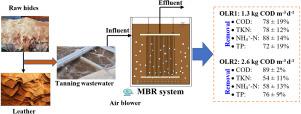Environmental Technology & Innovation ( IF 7.1 ) Pub Date : 2021-07-22 , DOI: 10.1016/j.eti.2021.101810 Thi-Dieu-Hien Vo , Xuan-Thanh Bui , Bao-Trong Dang , Thanh-Tin Nguyen , Van-Truc Nguyen , Duyen P.H. Tran , Phuong-Thao Nguyen , Marisa Boller , Kun-Yi Andrew Lin , Sunita Varjani , Pau Loke Show

|
Tannery wastewater contains high pollutants concentrations such as nitrogen, organic matter, salinity, toxic metals, etc. Membrane bioreactor has been widely recognized as potential technology for wastewater treatment and reuse. Finding proper operating conditions and a strategy for fouling mitigation in MBR process is essential to application to tannery wastewater treatment. Herein, this study investigated the effect of organic loading rate (OLR) on the performance and fouling behavior of membrane bioreactor (MBR) treating tannery wastewater during 280 days of operation. The MBR was operated under the low fluxes of 4.2 and 8.3 L m h−1, corresponding to organic loading rates of 1.3 (OLR1) and 2.6 kg COD md−1 (OLR2). The results show that the COD removal was obtained at 78 ± 19% and 89 ± 2% for OLR1 and OLR2, respectively. For the former condition the average removal of total Kjeldahl nitrogen (TKN) and NH-N reached 53%–68% and 58%–70%. TKN removal was mainly contributed by cell assimilation. Incomplete nitrification was due to high TDS (11,000–16,790 mg L−1) and the presence of free ammonia ( 6.77–31.11 mg L−1) concentrations under pH 8.7–8.8. Membrane fouling rate was strongly governed by operated flux. At flux of 4.2 LMH the fouling rate was as low as 0.19–0.4 kPa d−1 while the fouling rate accelerated (1.87–1.93 kPa d−1) as increased two times flux . These findings proposed a low flux of 4.2 LMH for MBR operation in treating real tannery wastewater. It was found that influent total suspended solids (TSS) played a crucial factor in spiking mixed liquor suspended solids (MLSS) into MBR. Thus, a pretreatment process is suggested to remove major suspended solids from raw tannery wastewater prior to biological treatment.
中文翻译:

有机负荷率对膜生物反应器处理制革废水处理性能的影响
制革废水含有高浓度的污染物,如氮、有机物、盐度、有毒金属等。膜生物反应器已被广泛认为是废水处理和回用的潜在技术。在 MBR 工艺中寻找合适的操作条件和减少结垢的策略对于应用于制革废水处理至关重要。在此,本研究调查了有机负载率 (OLR) 对膜生物反应器 (MBR) 在 280 天运行期间处理制革废水的性能和污染行为的影响。MBR 在 4.2 和 8.3 L m 的低通量下运行h -1,对应于 1.3 (OLR1) 和 2.6 kg COD m 的有机负荷率d -1 (OLR2)。结果表明,OLR1 和 OLR2 的 COD 去除率分别为 78±19% 和 89±2%。对于前一种条件,总凯氏定氮 (TKN) 和 NH 的平均去除率-N 达到 53%–68% 和 58%–70%。TKN 去除主要是由细胞同化造成的。不完全硝化是由于高 TDS (11,000–16,790 mg L -1 ) 和游离氨 (6.77–31.11 mg L -1 ) 浓度在 pH 8.7–8.8 下的存在。膜污染率受操作通量的强烈控制。在通量为 4.2 LMH 时,结垢速率低至 0.19-0.4 kPa d -1,而结垢速率加快(1.87-1.93 kPa d -1) 作为通量的两倍。这些发现提出了用于处理真正制革废水的 MBR 操作的低通量为 4.2 LMH。结果表明,进水总悬浮固体 (TSS) 在将混合液悬浮固体 (MLSS) 掺入 MBR 中起着至关重要的作用。因此,建议采用预处理工艺在生物处理之前去除制革原料废水中的主要悬浮固体。


























 京公网安备 11010802027423号
京公网安备 11010802027423号